World Dream Bank
home -
add a dream-
newest-
art
gallery-
sampler-
dreams by
title,
subject,
author,
date,
places,
names
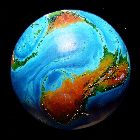

KAKALEA
by Chris Wayan, 2012-2015
for all who've gambled and lost
Kakalea basics--map--geology--
creatures--
Building Kakalea
More worlds? Planetocopia!
RECIPE FOR A BAD-LUCK WORLD
Most of Planetocopia's models are sharply unlike present-day Earth, yet have flourishing life; my aim was to broaden readers' ideas of where life can bloom. Kakalea is the opposite: a model showing how a true Earth can go surprisingly wrong. By the numbers, Kakalea's nearly Earth's climatic and geologic twin--large, adequate air, water and temperature. Should be Eden! But...
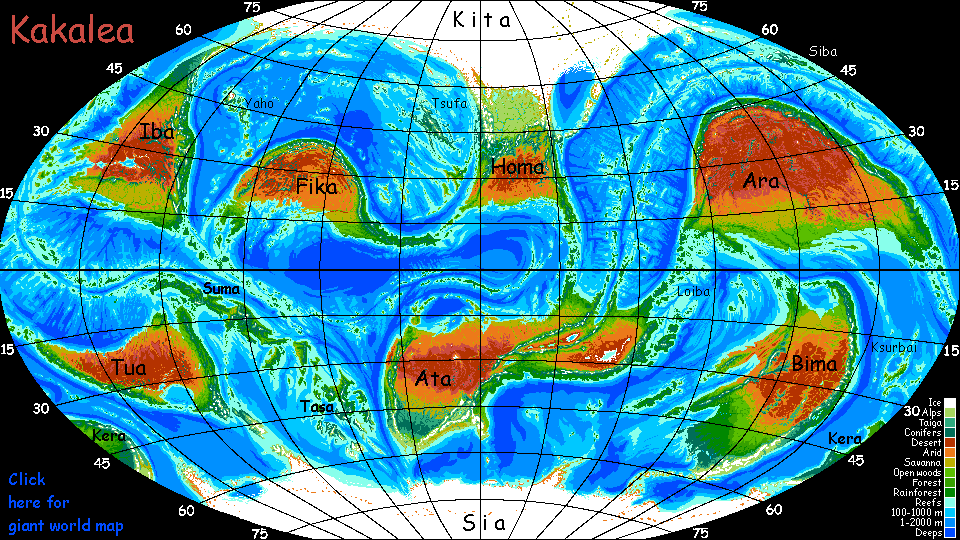 ...a Series of Unfortunate Events turned Kakalea's continents into Australias, Antarcticas and mini-Siberias. Most land life is coastal; inland, it's grim. Something similar happened on Earth during the Triassic--the supercontinent of Pangea had huge central deserts and monsoon weather on the coasts--long droughts, then floods. But Kakalea's not Pangea; its continents are modest-sized and broken up, with broad seas around them--indeed, so evenly spaced as to look a bit artificial. They are: I spaced them to banish even a hint of Pangeism, to emphasize a very different climatic problem, one that can arise despite plenty of access to the sea. All you need is a lot of land from 15-35° north or south, a modest mountain range on the windward shore, et voilą! Saharas everywhere. Such deserts run right to the coast in many spots. The Australian problem, writ worldwide!
...a Series of Unfortunate Events turned Kakalea's continents into Australias, Antarcticas and mini-Siberias. Most land life is coastal; inland, it's grim. Something similar happened on Earth during the Triassic--the supercontinent of Pangea had huge central deserts and monsoon weather on the coasts--long droughts, then floods. But Kakalea's not Pangea; its continents are modest-sized and broken up, with broad seas around them--indeed, so evenly spaced as to look a bit artificial. They are: I spaced them to banish even a hint of Pangeism, to emphasize a very different climatic problem, one that can arise despite plenty of access to the sea. All you need is a lot of land from 15-35° north or south, a modest mountain range on the windward shore, et voilą! Saharas everywhere. Such deserts run right to the coast in many spots. The Australian problem, writ worldwide!
The result? Kakalea has more land than Earth, yet only a tiny fraction of it's fertile--a dozen Chiles, a few Argentinas, Javas, Sahels, Alaskas... and that's it. These green lands are just bright wrapping paper around dreary lumps of desert--over 100 million square kilometers of it!
If Kakalea seems heavy-handed--seven Australias?--it's because so many of my readers find coastal deserts on my other world-models unconvincing, and write in about my climatic "error". Yet Earth has at least a dozen such coastal deserts! I suppose the Old World examples like Mauritania, Egypt and Libya, Pakistan, the Red Sea and Gulf states could all be blamed on the sheer size of Eurasia. But the Atacama, Sonora, Western Australian and Namib Deserts aren't caused by a supercontinent upwind! Location, location, location...
WHY KAKALEA?
My INNER SCIENTIST says: "I was feeling contrary. And it's been hot--record heat and drought in my country. But our richest political party still claims global warming is a fraud, even as their supporters watch their farms dry up. I wanted to show how severely climate can cripple culture--and life itself--even without a catastrophic CO2 buildup."
My INNER ARTIST is embarrassed. "See, the truth is, I just hungered for that lovely contrast between red-orange and blue-green, on a planetary scale. It's easy. Enlarge Australia. Now paint a second. A third, a fourth... Ooh, pretty!"
STATE OF THE PROJECT
Done for now. I've roughed in wind and cloud patterns, rainfall, and the ensuing vegetation--or rather, lack of it. Some tours are still skeletal. But then, maybe that's all they deserve. Kakalea's a simple place--a few dozen coastal strips and you've seen all the essentials. You can't even travel inland, in many cases--in Kakalea's thin air, the coastal ranges are often too high for Terrans to safely cross. Now that I've got a hundred or two illustrations of the coastal lands and peoples, I may leave it at that and shift back to work on Capsica, Abyssia, Inversia, Libratia and Xanadu, where there are harder problems to solve.
I've used Kakalea to show more of my work process than before--so many readers ask about it on previous planets, where I was in such a hurry to build that I didn't even document the process. I don't always start with a globe, but I did this time--roughed in continents and seas, plates, trenches and rifts, then built the major mountain ranges, all before I mapped a thing on paper or ran the numbers. The sketch below was my first paper map, working out the continents' areas and names (all mnemonic: they echo names (mostly of deserts) in similar locations on an Earth globe, so I'd keep track of their relative positions. See if you can guess them--or see nomenclature below.)
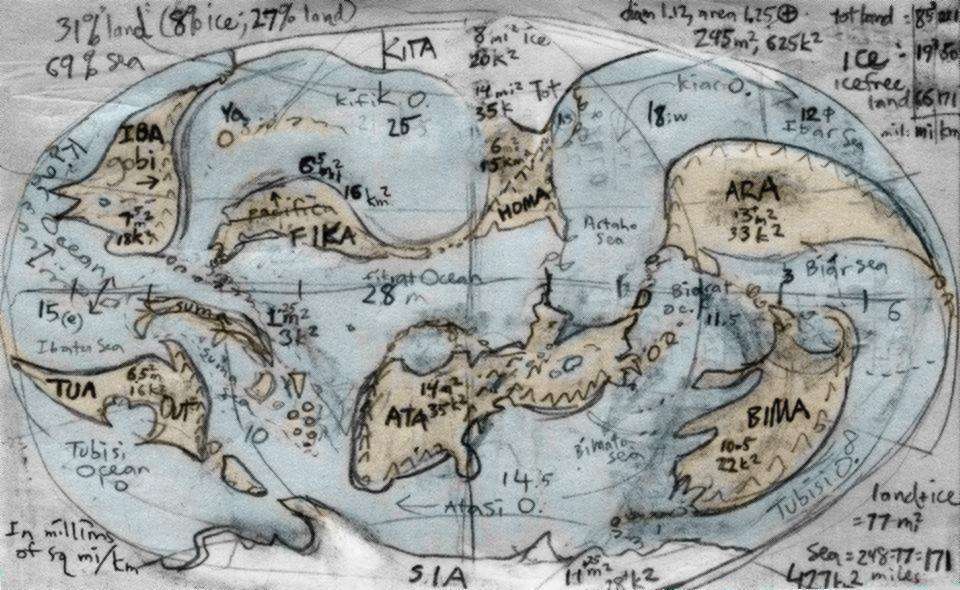
Kakalean creatures? Without landbridges, each continent will be Australian, with unique megafauna. Thin air and high gravity mean large-brained animals will be too heavy to fly, enforcing isolation. Diverse? Worldwide, yes, but on each landmass, they'll be sparse: small populations clinging to the coasts, or desert migrants with big ranges.
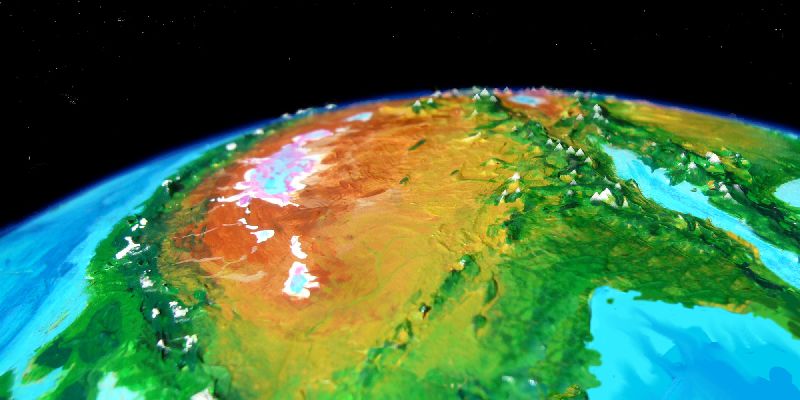
What will they look like? Well, since Kakalea is the planet that can't quite get it right, I'm populating it with half-baked species made of sawed-up glued-together Barbie dolls (probably singing "Here on the Island of Misfit Toys"). I was already building a troupe of modern dancers who are Barbie centauroids... so their floating theater will soon be touring all around Kakalea's coasts and islands, meeting even funnier-looking locals made of spare Barbie parts. Octopus Barbie, Triffid Barbie, Indescribable Thalidomide Barbie. Yes, nothing adds realism to science like Barbie.
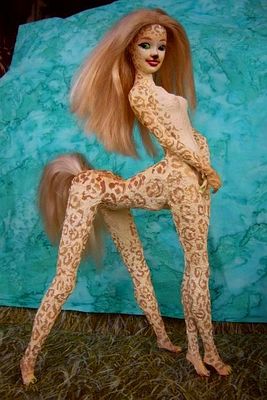
Shya, a typical Kakalean: a gracile centauroid
| 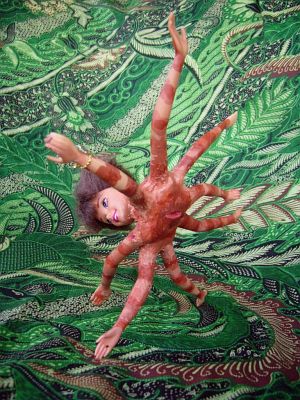
Octana, an amphibious girl from the Biarati Is.
| 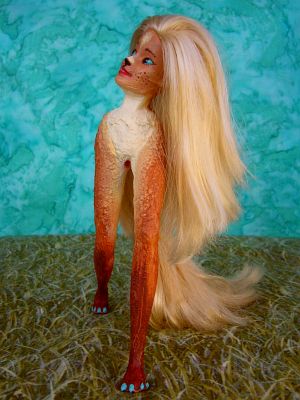
Pelva, a soccer fiend on the Isle of Ksurbai
|
Kakalean civilizations? Speaking technologically none--Barbie-rism. Sorry. No, there's logic behind this, and it's not that Barbie can't do math. She can, and so can Kakaleans. Civilization's developing slowly for a geographic reason. No single region has the population base to advance quickly!
But culturally, Kakalea will be diverse. I suspect quite a few regions will make it to Renaissance level, fed by sea-trade. But rather than Civilization, I expect civilizations--emphasis on the plural. With flight so difficult for big-brained megafauna and a dozen scattered coastal strips the only places fertile enough for surpluses, I expect a cultural pattern echoing the biological one--diverse, isolated, but a bit thin on the ground (small, isolated populations advance slowly). No Europe, India or China, but lots of New Zealands--and perhaps Englands or Japans.
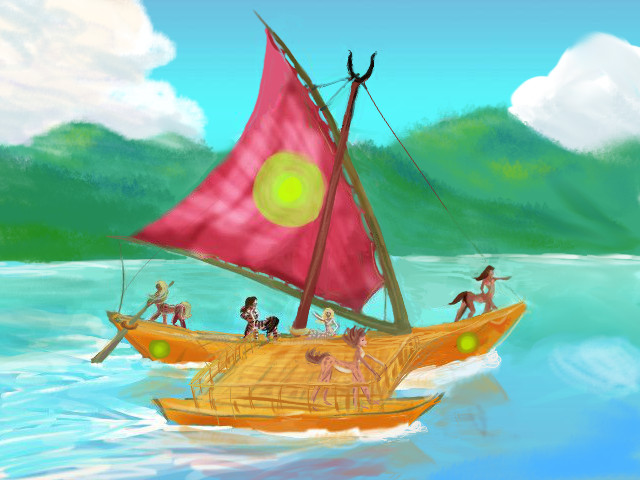
There may be an Age of Discovery (and imperialism) as on Earth, but I have my doubts. Europe's conquests were the fruit of military superiority forged by dozens of rival societies separated by natural boundaries yet living as close neighbors--classic frenemies! But Kakalea lacks a crucible like Europe.
If any Kakalean strip DOES start industrializing it'll dominate for generations, but this may be more commercial than military; with each strip-culture growing in enforced isolation, Kakaleans may not even have the concept of large-scale war... or nations. More lives may be lost to diseases spread by trade and exploration. That's true even in our world, of course; smallpox killed more in the Americas than war and slavery combined, and influenza probably outslaughtered all the guns of World War One. Still we gave it a good try, now didn't we? But on Kakalea, famine (mostly drought-induced) and plague (trade-spread) may utterly outweigh war.
Trade spreads plague, yes; but trade is also the only way Kakaleans will progress. Population and resources in a single coastal strip are so limited! It was no coincidence that the first Earth people to industrialize led the world in sea-trade. Okay, libertarians, you can claim it was the English socioeconomic system if you like. But that arose largely from the cosmopolitanism fed by worldwide trade.
And if a similar society does bloom on Kakalea, I expect sea-trade will feed it.
KAKALEAN FUTURES
Will Kakalea always be this barren? Not at all! We just caught her on a bad-hair day. In deep time, Kakalea's continents will creep out of the dry zones, or splinter, or merge, or snag and swing round till their mountains no longer block storms. Or a polar continent will drift off-center and thaw, forming inland seas and rainy new coasts where deserts now stretch. Just a passing drought!
Kakalea may have been more fertile than Earth, 100 million years ago. And may be again.
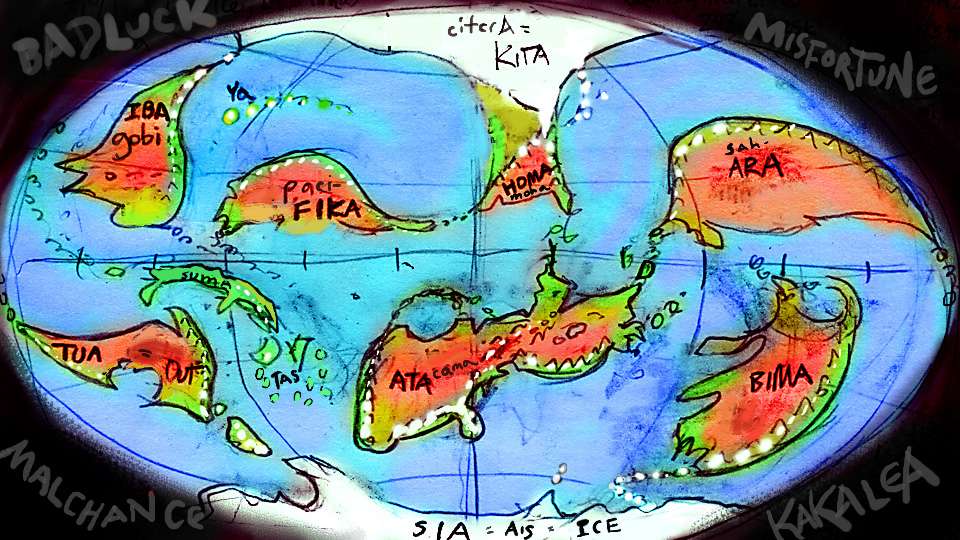
THE NUMBERS
- Sun = a yellow star of 0.9 solar masses. Luminosity about 65% of Sol's.
- year = 240 Terran days long; 320 local days.
- Insolation: 15% more than Earth gets. A dimmer sun, but Kakalea's just 0.75 AU away.
- Axial tilt = 22° --almost Earth's.
- Mass = around 1.52 Earths. Not a Super-Earth; just a Mildly Pudgy Earth.
- Density = 6 gm/ml, about 10% denser than Earth. Chemistry of the core, mantle and crust are quite Terran; the core, by far the densest bit, just happens to be larger, skewing average density.
- Diameter = 14,290 km (8874 miles), 12% larger than Earth.
That's equatorial diameter. Polar diameter's 160 km (100 mi) less--Kakalea has more polar flattening than Earth. Equatorial circumference is about 45,000 km (28,000 mi), so eight degrees is about 1000 km; 13 degrees, 1000 mi.
- Gravity = 1.22 G.
You'll weigh more. Beware achy knees, sore arches, tripping over your feet. By itself the higher gravity has no profound consequences for life, but combined with thinner air, it restricts the size of fliers to half that of Earth, and confines life to lowlands--but then, Kakalea has no Tibets. See, it's not totally unlucky! If Kakalea had a Tibet, its stratopheric air would leave it as dead as Mars.
One oddity: 1.22 G is an average. Earth's surface gravity varies too, but only 1% or so. Kakalea spins faster than Earth, so centrifugal force flattens the poles more and creates a larger equatorial bulge. Since you're closer to the center of mass at the poles, gravity there's nearly 1.24 G, versus just 1.21 at the equator. Not all this tropical weightloss is from the Bulging Waistline Effect; centrifugal force also subtracts a bit, over half a percent.
- Day=18 hours. The short day keeps temperature swings Earthlike despite Kakalea's thinner air. This sounds nice to land animals like most of my readers, but in the broader ecological view it's one more 'Unfortunate Event'. A long day and harsh temperature swings might have helped Kakalea, bringing more night rains and afternoon thunderstorms to its many arid lands. Alas for good weather!
- Satellites=3 small moons and a faint ring. The moons are small--largest only 1500 km across (900 mi). They lack enough mass to generate large tides--Kakalea's hot core is mostly from solar tidal stress and radioactive decay. Apparent diameters are about half Luna's, a third, and a fourth as wide, but they're made of somewhat brighter rock than Luna (dark as moons go) so night illumination ranges from several times brighter than Venus-light on rare moonless nights (from the rings), to comparable to a half-moon when all three are up. Since the light's more consistent than Luna's, Kakalean life is more active at night. Few lunar biocycles, though.
- Kakalea's surface area = 640 million sq km (247 million sq mi),
24% larger than Earth's.
- Land = 27%, 172 million sq km (66.5 million square miles). 'Land' here excludes ice. It's about 30% more than Earth's ice-free land. If, as many atlases do, you count ice as land, the numbers are 35% land compared to Earth's 29%. No matter how you count it, there's a lot.
- Sea = 65%, 417 million sq km (161 million square miles). A bit larger than Earth's seas in area (but not volume--shallow!)
- Ice = 8%:, 50 million sq km (19.5 million square miles), or about three Antarcticas; bigger than Eurasia! The volume of ice is just twice
Earth's; caps top out at just 2-2.5 km (7-8000'); stronger gravity and thinner air prevent ice from piling up to Antarctic heights.
- Relief= A bit less than Earth but more than Venus. From highest peak to deepest trench is 15 vertical km (Earth: 20. Venus: 14). Geologically, it's quite Earthlike--the higher gravity just flattens it proportionately. But low sea levels expose more of its modest relief, so Kakalea looks ruggeder to a tourist's eye--almost Martian in spots.
- The highest peak is Mt Yai, a shield volcano rising from the western Kifik Sea; it's 9 km above sea level (29,500'), much like Everest. From its undersea base, 2 km down, it's 11 km or 36,000' tall, a near-perfect twin to Earth's tallest freestanding mountain, Hawai'i. In Kakalea's higher gravity this is surprising. The reason is local: the sea floor above this hotspot is moving quite slowly, so that lava flows build up around the same few vents; Yai is more like a Martian volcano than Hawai'i. A chain of islands and reefs does mark older vents, but it's much shorter than Hawaii's.
- Greatest ocean depth is the Wapiyu Trench, about 6 km (20,000').
- Total water: half Earth's. This does not create the deserts! Kakalean seas are comparable in area to Earth's, they're just shallower, averaging 1.7 km deep (5600'), 45% of Earth's mean depth. But abysses don't generate rain--surface water does! Kakalea has plenty that, and plenty of rain--the tropics have more than Earth's. The trouble is, most of it rains back into the sea, not on land. Not a hydrological curse, a geographic one.
- Cloud cover: less than Earth (all those deserts!) but not as much less as you land-animal readers think. Even on Earth, most clouds are over the seas, after all.
- Rainfall: like Earth, Kakalea has plenty of high-latitude storms and even more tropical storms, since equatorial waters are warmer (a hot current circles the equator, unblocked by any Africas or Panamas). It's just that most stormtracks never hit land, and those that do mostly hit coastal mountains.
- Albedo (reflectivity): roughly Earth's. Yes, there are somewhat fewer clouds in mid-latitudes, but deserts are generally bright. And there's more ice in the high latitudes.
- Air pressure: 0.6 atmospheres at sea level, and dropping faster with altitude than in Earth's mountains, due to higher gravity. Main ecological effect: rainclouds can't transport as much moisture high up; they drop their burdens lower. Mountains are thus nearly 25% "taller" climatically than Terrans expect. (They're also quite dangerous to cross without bottled oxygen; you'll notice my regional tours hug the coasts). Kakalean life flourishes up to 2-3 km in warm latitudes but thins out quickly above.
- Oxygen = 18%; partial pressure of oxygen is about 55% of Earth's, equivalent to Terran air about 4 kilometers up (13,200'). Kakalean winged life is mostly small; less oxygen and less air to grab, making flight difficult. Higher gravity means even this thin atmosphere thins out faster as you climb, too. WARNING! Even acclimatized Terran visitors MUST stay low: altitudes above 1 km are unhealthy (equivalent: 5200m or 17,100'), and above 2 km are hazardous (6400m or 21,200').
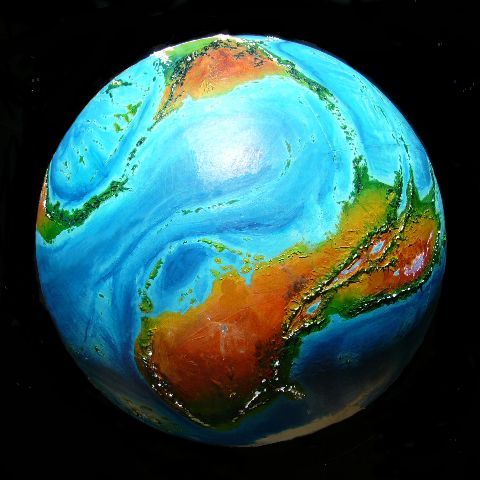
- CO2 = 450 ppm. Remember, the air's thin, so that's less than it sounds like; the same as 270 ppm at one atmosphere. Earth's preindustrial level! Those big, exposed rift zones suggest vulcanism's as common as on Earth, and it's a splendid source of CO2. Nor are there many forests to suck it up. So why isn't it 500, 600, 700? Dust from Kakalea's deserts blows into the seas, fertilizing plankton, and all that sea life is a CO2 sponge. Negative feedback loop: heat up the land, deserts spread, more dust makes the seas bloom, sucking up extra CO2, cooling the land... So CO2 stays roughly in the Terran range.
- Tectonics = vigorous. That yellower sun is cooler, dimmer and denser; Kakalea orbits closer. Tidal forces on Kakalea, even without a large moon, are about as strong as they are on Earth. It's not coincidence Kakalea looks so much like Earth; the forces shaping it are similar in strength.
- Temperature = 15°C: Earthlike. More sun, but thin air. The poles are cooler than Earth's (especially our balmy north), the low latitudes hotter. This is probably a cool phase; Kakalea gets warmer and wetter when one or both poles don't have continents under them, just sea ice. Shallow seas, evener temperatures, Polynesias all over, smaller greener continents. We just caught Kakalea on a bad day.
- Habitats = quite Earthlike. Only the proportions are alien. From largest to smallest: desert, arid savanna and scrub, ice, montane forest and taiga, prairies and steppes, rainforest, Mediterranean, broadleaf forest.
- Biodensity = 71% of Earth's. Though it's a big world--total biomass is 87% of Earth's. But it takes a lot of travel to find it! Especially on land.
- Land = 32% of Earth's land biodensity, no more. So much desert and ice, so little forest! Total land area is larger, so the land biomass is about 40% of Earth's. Still impoverished.
- Sea = 90% of our oceanic biodensity; the seas are bigger, so the total biomass is 10% more than Earth's. The twin polar caps have sucked up water and bared most continental shelves, so despite the generally shallow seas, coral reefs and kelp forests are no more extensive than Earth's. And few rivers nourish coastal waters with sediment. But fine windblown dust from the deserts feeds plankton far out to sea. Neither overfed dead zones nor nutrient-starved oceanic deserts: juuuuust right. If you're a fish.
- Intelligent species=
Seven known. One dominates because it built boats first; the others are mostly Galapagos curiosities, though one is now spreading into niche habitats. All seven are land or tidepool dwellers--no deep-sea swimmers have hands, and no fliers (thin air and high gravity keep fliers too small to be intelligent). Kakalea's landmasses are more cut-off by water than Earth's, confining all seven to their native regions--essentially, seven Australias--until one masters sailing. But I'll picture Kakalea long after that's happened. Indeed, the way I'm projecting it, many of the six current minorities evolved from castaways of the dominant mariner species.
Our mariners evolved on savanna, as humans did. I'm not claiming savanna's magically sapiogenic (intelligence-producing)--but on Kakalea, there's so damn much of it! Tilts the odds toward it. They'll be leggy, gracile, heat-adapted creatures--I've pictured them as centauroid runners (see Peoples of Kakalea) but they could just as well have been sentient kangaroos or elephants or coyotes or even (gasp) humanoid. Regardless of shape, they'll be psychologically rather human; diet, sex and aggression levels may differ, but they share that legacy of wandering over grassland and desert--a big two-dimensional space full of potential tools (including fire), predators to flee or fight... where co-operation and social intelligence pay off.
- Technology = slow to develop. I anticipate small, isolated civilization(s) unaware of each other for a long time. I could be wrong; does Kakalea have advantages we're blind to? Shallow seas rich in islands, so light, small boats can cross those gaps. Worldwide trade may start up earlier than Earth's and be decentralized. A (dare I say it) worldwide web.
- Nomenclature: Kakalea is just bad Greek for bad luck. Continental names are reminders of places, mostly deserts, in similar locations on an Earth globe--though many are cut off, backward or scrambled (Iba=Gobi, Ata=Atacama, Tua=Out(back), Homa=Mohave, Bima=Namib; Ara=Sahara. Not all deserts: Fika=Pacific, Yaho=Hawai'i, Suma=Sumatra, Sia=Ais ('ice'), Kita=Arctic backward (plus Japanese 'north')). Just mnemonics, so I don't get lost during construction! Local names will arise from native languages. If poor Kakalea ever evolves any natives...
THE LESSONS OF KAKALEA
Previous models in Planetocopia have generally emphasized the message "We don't need to look for other Earths; our search can be much broader than that." Kakalea shows the opposite; all the numbers can look Earthlike, and yet...
 Kakalea basics--map--geology--
creatures--
Building Kakalea
Kakalea basics--map--geology--
creatures--
Building Kakalea
LISTS AND LINKS: More worlds? Planetocopia! - dreams of other
worlds - ecology - climate change - evolution - natural disasters - terraforming - sculptures and 3D art - Barbie sculptures: the Cendancers
World Dream Bank homepage- Art
gallery- New stuff- Introductory sampler, best
dreams, best art- On dreamwork- Books
Indexes: Subject- Author- Date- Names- Places- Art
media/styles
Titles: A- B- C- D- E- F- G- H- IJ- KL-
M-
NO- PQ- R- Sa-Sk- Sl-Sz- T- UV-
WXYZ
Email: wdreamb@yahoo.com- Catalogof art, books, CDs - Behind the Curtain:FAQs, bio, site map - Kindred sites